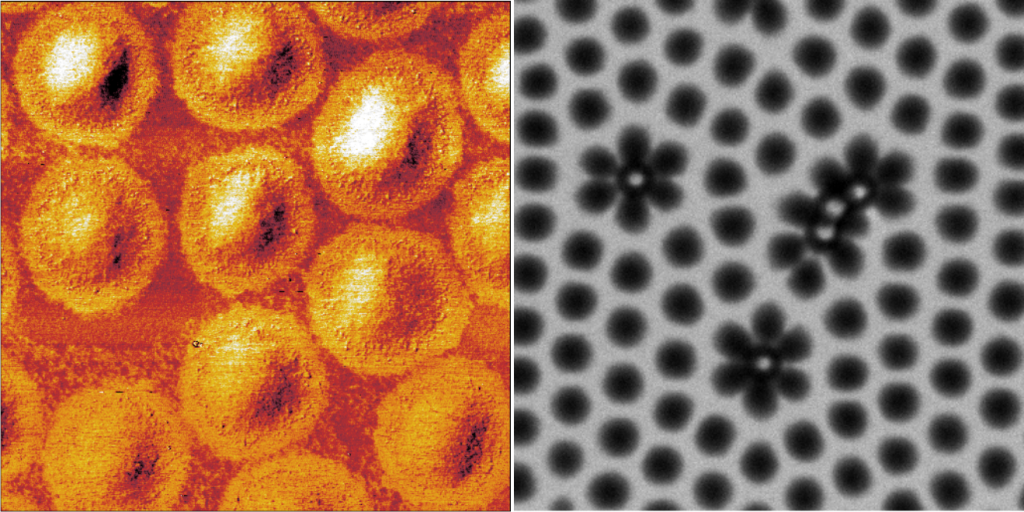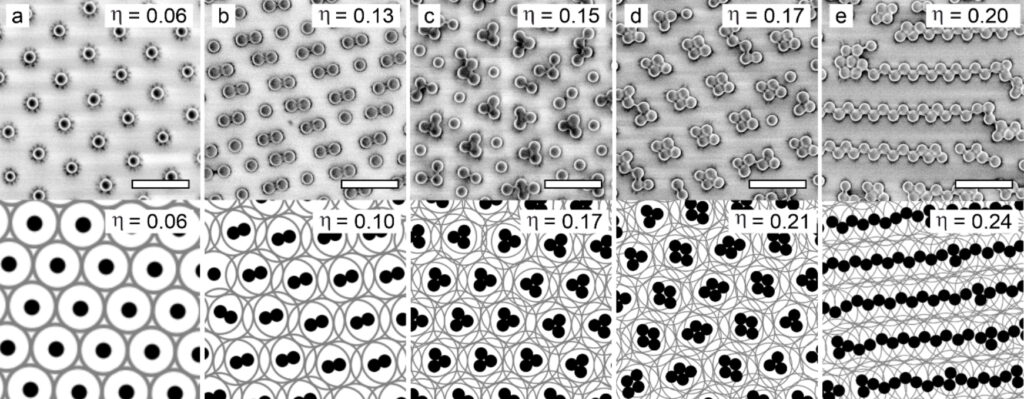Particles at Interfaces
Colloidal particles strongly adsorb to liquid interfaces, which provides an ideal two-dimensional confinement for the investigation of self-assembly processes. We correlate the interfacial properties and morphology of colloidal particles and soft microgels with their self-assembly and phase behaviour. We use this fundamental understanding of interfacial self-assembly to control the order and symmetry in colloidal monolayers.
Soft Particles at Intefaces
Hard and soft particles strongly adsorb to liquid interfaces, leading to the formation of a two-dimensional crystal at the interface. The resulting particle arrangement is determined by the balance between attractive and repulsive forces of the interacting colloidal particles. While for hard spherical particles the capillary attraction generally leads to hexagonally close-packed monolayer at the air/water interface, soft microgel particles exhibit a more complex interfacial behaviour. They deform into a core-corona structure under the influence of surface tension at an interface. The interaction between these flattened coronae dominates the interfacial properties and the resulting phase behaviour. In the Vogel lab, we investigate this unique phase behaviour of microgels.

Key Related Publications
M. Rey, M. A. Fernandez-Rodriguez, M. Karg, L. Isa, N. Vogel
Poly‑N‑isopropylacrylamide Nanogels and Microgels at Fluid Interfaces
Accounts of Chemical Research, 2020 53 (2), 414-424
J. Harrer, M. Rey, S. Ciarella, H. Loewen, L. M. C. Janssen, N. Vogel
Stimuli-responsive behavior of PNiPAm microgels under interfacial confinement
Langmuir, 2019, 35 (32), 10512-10521
J. Harrer, S. Ciarella, M. Rey, H. Löwen, L. M. C. Janssen, N. Vogel
Collapse-induced phase transitions in binary interfacial microgel monolayers
Soft Matter, 2021, 17, 4504–4516
Phase Transititions of Core-Shell Particles
Core-shell particles are closely related to microgels with the difference that their cores are solid and consist of a different material than the shell. Particles with a soft polymer shell provide a wide playground to study interfacial phase behaviour, as the soft components can manipulate the interaction potential of the rigid colloidal particles. This modification results in non-hexagonal self-assembly structures, including dimers and chain and square packing as minimum energy configurations when a monolayer is compressed.

Key Related Publications
J. Menath, J. Eatson, R. Brilmayer, A. Andrieu-Brunsen, D.M.A. Buzza, N.Vogel
Defined core-shell particles as the key to complex interfacial self-assembly
PNAS, 2021, 118 (52), e2113394118
M. Rey, A.D. Law, D.M.A. Buzza and N. Vogel
Anisotropic self-assembly from anisotropic colloidal building blocks
JACS, 2017, 139, 17464
Acoustic Annealing
For applications originating from self-assembled monolayers, e.g surface patterning, large domains with uniform particle arrays are required. We introduce a simple method for increasing the crystal size of hexagonal particle arrangements by acoustic annealing of the interfacial particle monolayer induced by a loudspeaker.
Key Related Publications
J. Menath, R. Mohammadi, J. C. Grauer, C. Deters, M. Böhm, B. Liebchen, L. M. C. Janssen, H. Loewen, N. Vogel
Acoustic Crystallization of 2D Colloidal Crystals
Advanced Materials, 2023, 35 (2), 2206593